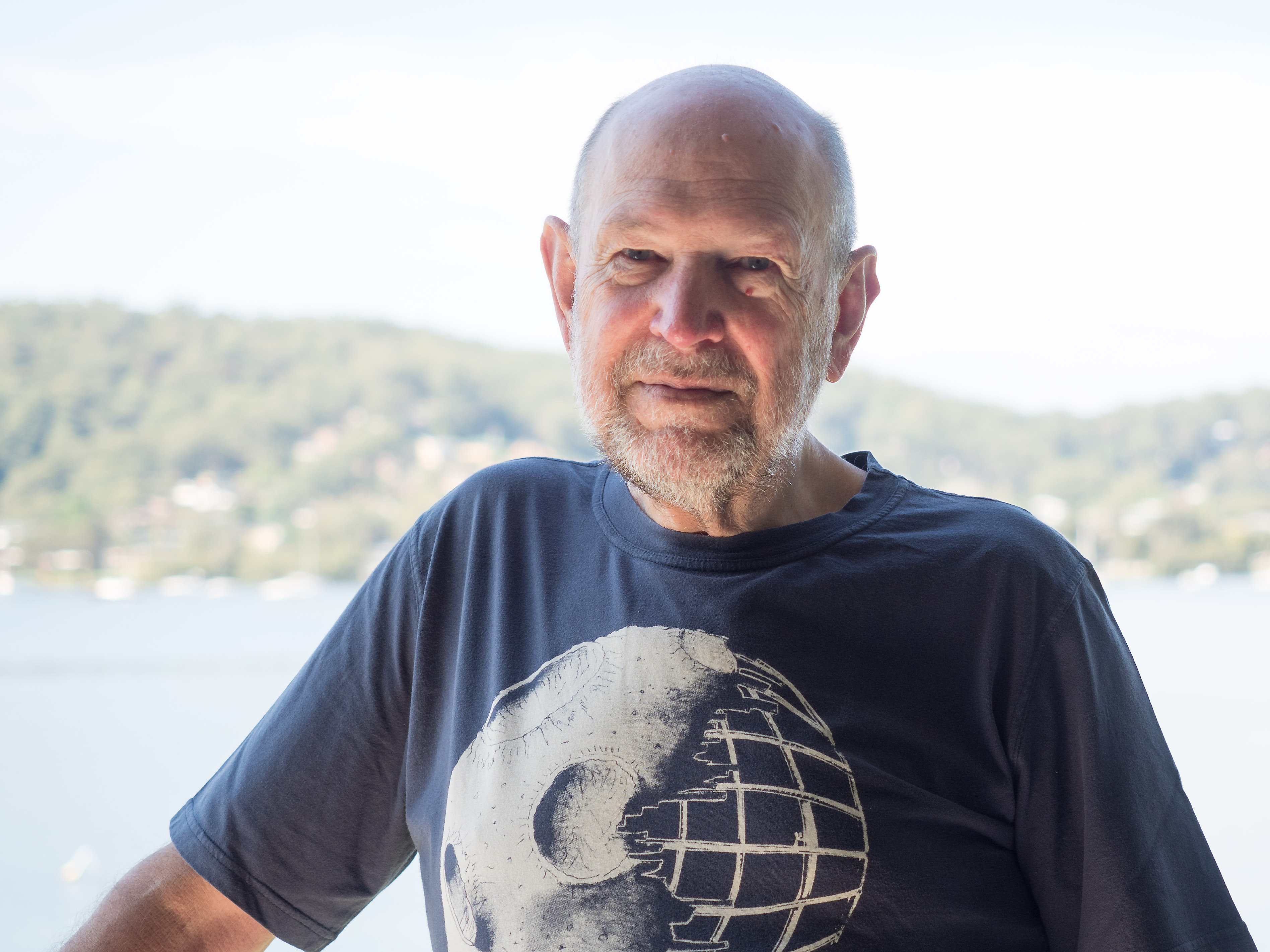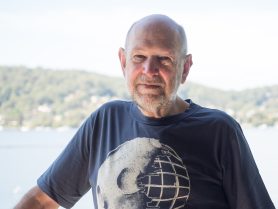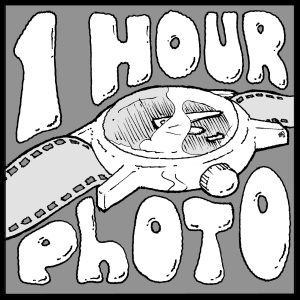 If you have any interest in Yashica TLRs, there is a chance you know who Paul Sokk is. Maybe you don’t recognize the name, but I’d be willing to bet you’ve visited his website, yashicatlr.com at least once.
If you have any interest in Yashica TLRs, there is a chance you know who Paul Sokk is. Maybe you don’t recognize the name, but I’d be willing to bet you’ve visited his website, yashicatlr.com at least once.
One of the earliest cameras I ever reviewed was the Yashicamat which I published back in December 2014 when the number of movie reviews on this site outnumbered camera reviews. (Click here if you’d like to read my take on “Moneyball”)
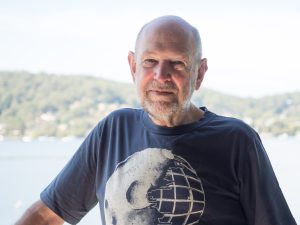
When I wanted to learn about that Yashicamat, I searched for it on Google and the first result that came up was a site called yashicatlr.com which belongs to an Australian collector named Paul Sokk.
I would later revisit Paul’s site again and again as my thirst for knowledge over Yashica TLRs grew. Paul’s site is one of the most thorough and nicest put together sites for a specific camera type out there. The best part is that not only does Paul regularly update it with new information, he’s very responsive to emails and questions from his readers.
Recently, I had written a review about the Yashica Pentamatic S and I was thrilled when I discovered that Paul had branched out beyond Yashica’s TLR and had a section dedicated to the Pentamatic. Was Paul finally about to include more than just Yashica cameras? Would he one day have as much info about the Yashica Electro, or even other brands? Maybe he would register the domain name flexarettlr.com and voigtlandersuperb.net. I had to find out more, so I called him up (I actually used Skype since he’s 11 time zones ahead of me) and had a little chat.
Mike E – Hi Paul! It’s great to have a chance to talk to you and get to know more about you and your site. As you may or may not remember, you helped me with some questions I had about my first Yashica TLR back in 2014 and I’ve been a frequent visitor to your site ever since. Your site is so informative and well written, you must really have a passion for Yashica TLRs. How did you get started?
Paul S – Thanks Mike! I make an effort to respond to any questions that I receive as I’ve asked many questions of other people myself.

I first became interested in photography as a teenager in the 1960s. I mostly did it as a hobby, shooting weekend weddings in the early 1970s for extra money, but it was never something I quit my day job for. I mainly shot 35mm film and had some experience in a dark room, but by no means was I professional. In the early 2000s when digital photography started to catch on, I bought a digital point and shoot and found the digital workflow liberating.
After a few years, I started to miss the look and feel of the all metal, mechanical cameras from my early days, so I picked up a few early Pentaxes and started shooting again. This led to an interest in Soviet Leica copies. Back then, I wanted to learn as much as I could about the cameras I was using and found some really terrific information about the Pentax and Soviet cameras on the Internet.
I then wanted to explore medium format cameras, specifically the Twin Lens Reflex style, and I found Rolleiflexes to be too expensive, so I decided to try out a Yashica TLR instead. My first one was a Yashica D and after starting to research it, I found that there was very little information out there about it. There weren’t any resources for Yashica TLRs like there were for other cameras.
ME – So in essence, you stumbled into Yashica TLRs out of economic necessity?
PS – Yep, that’s basically it!
ME – That’s funny because I started out the same exact way, except mine was a Yashicamat! I later would pick up a Yashica D and I love it.
PS – Interestingly, that first Yashica D was dead on arrival when I first got it. There was something wrong with the focusing mechanism that was damaged and I couldn’t get anything correctly in focus. I ended up buying a Yashica LM to replace that first one and it just escalated from there.
ME – You mention on your site that you don’t consider yourself a collector. How many do you currently own?
PS – I currently have 35 Yashica TLRs in my collection that include some duplicates, and a few that are non working. I tend to favor the earlier models over the later ones, but my collection is hardly complete.
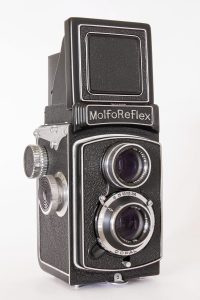
ME – What are your rarest models?
PS – I have 3 Pigeonflexes which are the original Yashima TLRs that aren’t very common anymore, along with one called the MolfoReflex in near mint condition which is a rebadged Yashicaflex A-I. They were produced for a Swedish importer and only about 400 of these were ever made, which makes it the rarest in my collection.
ME – So after those first two cameras, did you start putting together your website to fill in the void of information about Yashica TLRs out there?
PS – No, not right away. At first, I wrote down what I had found about them in a database that I maintained myself. I’d describe myself as a bit obsessive with details. I worked for 35 years in government administration, so getting the facts right is important to me.
In the mid 2000s, there was a website called tlr-camera.com run by a guy named Barry Toogood who had put together a large amount of information about all kinds of TLRs including Yashica. It soon became clear to me that the information I was collecting in my database was telling a very different story to Barry’s version. I contacted him a few times with things I thought needed correcting. I couldn’t convince him that his own research had shortcomings, but to his credit, and my lasting gratitude, he suggested that I create my own Yashica web page that he would host on his site.
I wrote my stuff in Word and he would convert and format it to HTML. We operated that way for over twelve months, not altogether happily however. Barry was frustrated with the number of amendments he was being deluged with and I was frustrated that I couldn’t make my changes instantly. In the end, it inevitably occurred to me that I needed my own site. The current version of my site went live around November 2011 and it has continually evolved from there.
ME – I am familiar with Barry’s site as I’ve been there a few times when I was researching Flexaret TLRs and a few others. His site seems to only scratch the surface on the various TLRs out there and to this day, has never gone anywhere near as in depth as you have. Has he ever expressed an interest to continue to update his Yashica section?
PS – In all fairness to Barry, I think his site is more about providing context for his remarkable collection than it is about being a reference source. I think that I didn’t really understand that at the time. I think Barry was probably relieved when I indicated that I was branching out on my own, and he immediately provided a link on his Yashica page to my new site. So, both the hosting of my original web page and linking to my site recognized my work to some degree, but as far as I can tell, nothing has been corrected on his site, nor has he referenced anything I have said.
Having said that, his site has been static for years, certainly from before I contacted him. In some ways, Barry’s reluctance to make corrections is what caused me to pursue this site and I guess I owe him thanks as if he had simply fixed up things, I don’t know what I would have continued to pursue my own site.
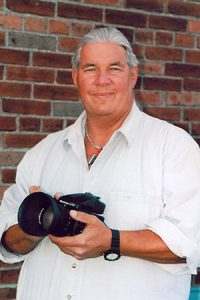
In addition to Barry’s encouragement to make my own site, I owe a lot to two big time collectors, Tom Heckhaus from the United States, and Leigh Harris from Australia. Both Tom and Leigh had, and still have a tremendous amount of knowledge about Yashica, and in the beginning, I collaborated with both of them which allowed me to expand what was originally just a single web page into what would become this entire site. Many of the images that I still have on display today are of cameras in Tom’s collection.
Soon after, I also collaborated with other collectors like Göran Årelind from Sweden, Sandu Baciu from Canada, and Chris Whelan from the US. Göran filled in the early Swedish connection including the research into the MolfoReflex and is also my “go to” technical guru. Sandu more than anyone has acquired some unusual examples. Chris, as you know, is a huge fan of the Pentamatic which you referenced earlier and has his own site dedicated to that camera.
ME – It seems that both decisions to buy your first Yashica TLR and to start your own Yashica TLR website came out of chance encounters! How fascinating!
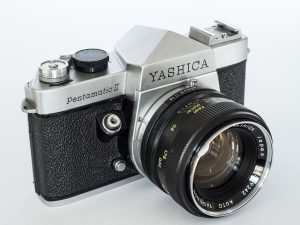
I’m glad you brought up the Pentamatic again as that is a really fascinating camera to me and one you and I recently collaborated on. It seems that there is still quite a bit of gray area as to the history of that camera. It is well known that Yashima (the original company of the Yashica brand) had acquired Nicca in 1958, and it’s often repeated that the Pentamatic first went on sale in very late 1959 and early 1960, but there has to be some overlap of Pentamatic development and Nicca ownership. My question is, was the Pentamatic already in development by Yashima prior to acquiring Nicca, or was Nicca developing the Pentamatic and Yashima helped them finish it?
PS – These are good questions, and ones that only recently have we been able to draw reasonably certain conclusions from, but everything we know is still just an educated guess as there simply aren’t any written records of exactly what happened.
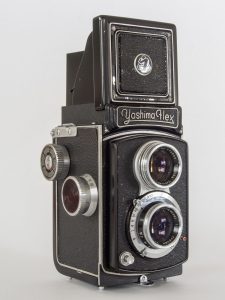
Before I answer your question, it’s important to know who Yashima and Nicca were prior to 1958. In the early 1950s, Yashima was almost exclusively a maker of German inspired TLR cameras that used leaf shutters. From the original Pigeonflex in 1953 to about 1957, most Yashica TLRs were simplified versions of the Rolleiflex and Rolleicords. In 1957, they expanded their offerings to 8mm movie cameras and in 1958 the leaf shutter equipped Yashica 35, but otherwise was almost exclusively known for their TLRs.
Nicca on the other hand, was a much smaller company that produced 35mm Leica rangefinder copies. Nicca’s cameras were very good, and competed with the likes of Canon and other Japanese companies, but their small size kept their volume and profits low. They had a great deal of expertise with 35mm cameras and focal plane shutters like the Leica had, but not much else.
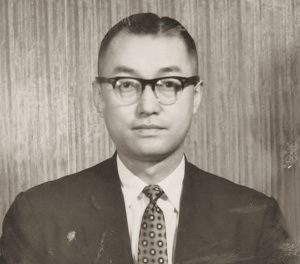
At first, when Nicca started to struggle, no one was interested in them as the Japanese optical market was flooded with camera companies. Yashima’s founder, Yoshimasa Ushiyama, had realized that rangefinder cameras were starting to fall in popularity in favor of SLRs and that Yashima would need to produce their own model if they were to stay competitive. By this time Asahi Pentax and Miranda already had their own SLRs with models from Minolta, Nikon, and Canon coming soon.
Yashima, sensing an opportunity to pick up the rights to a company that had experience with 35mm focal plane shutter cameras, swooped in at the very last minute and bought Nicca before they filed for bankruptcy, which meant they acquired all of their technology and knowledge at a bargain price. A Japanese language pamphlet I recently found announcing the release of the Pentamatic confirms that the camera was in development for three years.
What exactly constitutes three years is anyone’s guess, but it’s reasonable to assume that there’s no way an entirely new SLR could be designed from the ground up in what ended up being a little more than 18 months. Nippon Kogaku started work on the Nikon F in 1955 and didn’t release it until 1959. Canon, also spent over 3 years designing their first SLR.
It makes the most sense to think that Yashima had started development of the SLR prior to their acquisition of Nicca, and perhaps was part of the reason they were interested, so that they could incorporate their focal plane shutter into the new camera, something Yashima had no experience with.
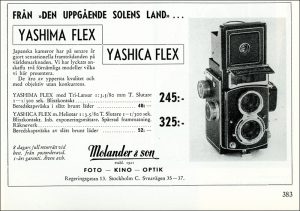
ME – Something I’ve read online is that Yashima’s name change from Yashima to Yashica was to honor the combined companies, Yashima + Nicca = Yashica.
PS – That’s not what happened. Although yes, Yashima did officially rename themselves to Yashica shortly after their acquisition of Nicca in 1958, they had been using the name Yashica on their TLRs since the release of the Yashica Flex B in December 1953.
It was common practice for camera companies to take on the name of their most successful product in an attempt to internationalize their name. Canon, Minolta, Nikon, Miranda, and nearly every Japanese camera maker eventually did this. The name “Yashica” was an already established and respected trademark far before the Yashima/Nicca merger. In August 1957, Yashima would open their first US office in New York, and that likely played a big role in their decision to change their name.
As for where the name “Yashica” came from, it was also common back then for a company to combine parts of their name with the “-ca” suffix to have a more international friendly name. The Leica was Leitz + ca = Leica, Konica was Konishiroku + ca = Konica, and even Nicca was originally called Nippon Koagku Seiki-sha, but later changed their name to Nicca.
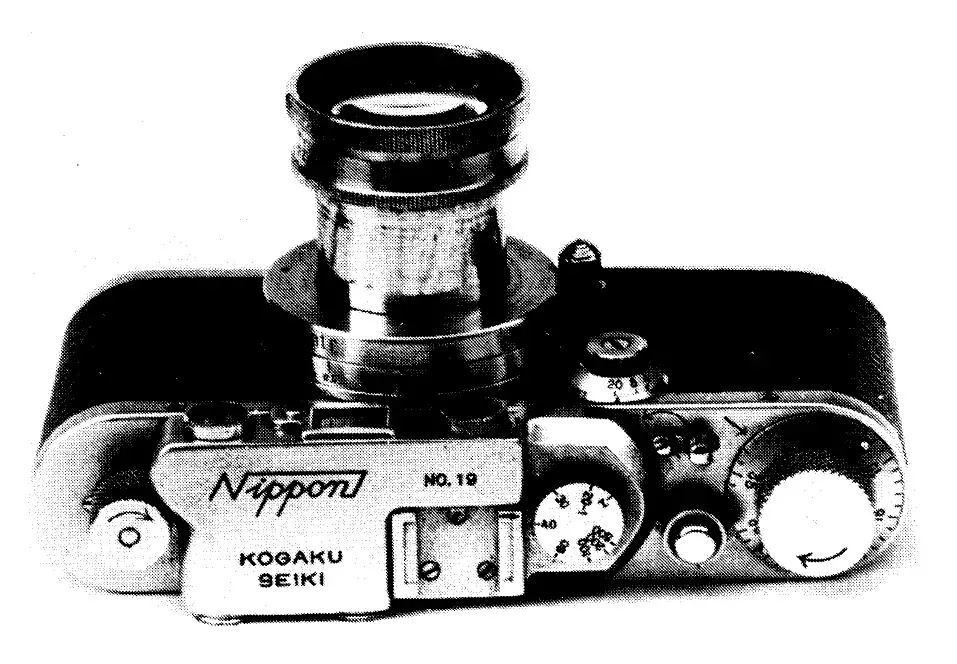
ME – When exactly did Yashima officially start referring to themselves as Yashica? I remember when researching the Yashica 35 rangefinder seeing that some early examples still have the name “Yashima Opt. Ind.” on the back, but later ones are identified as being made by Yashica.
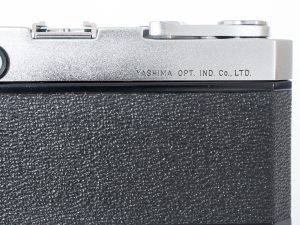
PS – The Yashica 35 first went into production in April 1958, the month before they acquired Nicca, but the name change on these cameras didn’t occur until the beginning of September so any made between April and early September will still have the old name.
ME – Besides their focal plane shutters, was there anything else that Yashima took from Nicca after their merger?
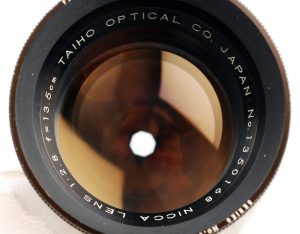
PS – Technically, Yashima and Nicca didn’t actually merge. Nicca remained a wholly owned subsidiary of Yashima and was rebranded under a new name called Taiho Optical. Now, what Taiho Optical actually did is very vague. The name Taiho was used on at least one telephoto lens and a few accessories, but there is not a lot of information as to what their purpose was, even though they appeared to still be their own company.
ME – Why wouldn’t Yashima just absorb all of Nicca? It seems like an awful amount of effort to operate the remnants of the company as a subsidiary and occasionally release products with their name.
PS – There’s not a lot of evidence of this on the Internet in English, but I’ve seen some old posts on Japanese sites that suggest Yoshimasa Ushiyama was a very spiritual man. He would often seek guidance from an adviser who told him that it would be bad luck to completely absorb Nicca and that he would need to wait precisely 8 years before taking any action to completely eliminate Nicca. I don’t know that anyone truly knows why his adviser believed this, but Ushiyama trusted him enough to wait until 1966 before completing the merger with Nicca, at which point Taiho ceased to exist.
ME – Wow, I think that’s the first time in my research for any camera or company where I’ve heard of a decision like that being made based on the advice of a spiritual adviser!
Moving on, I know you’ve recently expanded your site to include some info on the Pentamatic SLR and the Leica Thread Mount Yashica YE / YF rangefinders, but do you have plans to add any more models such as the Electro series to your site?
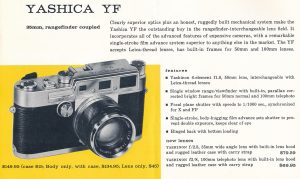
PS – I don’t think I will. My YE and YF page and the Nicca page accessible from that have been my current focus.
Before those, I added pages on the Yashica 8 movie camera, Yashica 35 and of course, Pentamatic. They are all beginnings which lead elsewhere, but they all shaped Yashica as a company which is my excuse for including them. Beyond that, they are not relevant to the TLR narrative. If I did anything else, it would have to be a new website, but I don’t think I have that in me.
ME – I’d love to have a YF as I think they’re one of the best looking Leica style rangefinders out there. I’ve lusted after one for a while, but never seem to find one cheap enough.
PS – They used to be pretty easy to come by on Yahoo’s Japan Auctions, but in recent years, there has been a huge uptick of Japanese sellers buying up all of the old cameras, separating them from their lenses, and then selling the body and lenses separately on eBay. It drives me nuts that they do this as these cameras and lenses have remained together for over half a century and then suddenly they’re separated just to make a profit. Nowadays it’s hard to find them for anything close to a reasonable price.

ME – I’ve heard of some collectors using services like Buyee.JP and Zenmarket to buy things from Yahoo Japan, is that who you use?
PS – I have used them, but I more often use one called Easy Auction Japan which works better for me.
ME – Maybe I’ll give it a try, but to be honest, the price of shipping is quite high from Japan to the US. How is shipping for you to get things shipped to Australia?
PS – It’s high no matter where I get things from. Getting things shipped to me from the US and Japan are both expensive.
ME – Have you had any luck acquiring cameras locally in Australia?
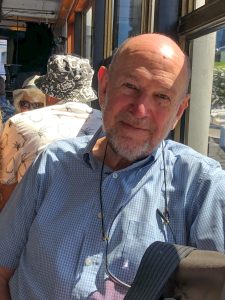 PS – Unfortunately no. Cameras that I’m interested in don’t seem to turn up much in Australia, let alone TLRs. I’ll see the occasional point and shoot camera at a garage sale but that’s about it. I don’t know why, but I feel like Australia doesn’t have as strong of a culture for cameras as Japan or the US. My parents were refugees from Estonia and moved to Australia after the war, and growing up we didn’t even own a family camera. When I was in school, I don’t ever remember other kids or families with cameras, you just didn’t see it. Maybe it was different in other areas of the country, but that was my perception from where I grew up. My first camera was a Brownie Starlet that my father bought for me around 1960.
PS – Unfortunately no. Cameras that I’m interested in don’t seem to turn up much in Australia, let alone TLRs. I’ll see the occasional point and shoot camera at a garage sale but that’s about it. I don’t know why, but I feel like Australia doesn’t have as strong of a culture for cameras as Japan or the US. My parents were refugees from Estonia and moved to Australia after the war, and growing up we didn’t even own a family camera. When I was in school, I don’t ever remember other kids or families with cameras, you just didn’t see it. Maybe it was different in other areas of the country, but that was my perception from where I grew up. My first camera was a Brownie Starlet that my father bought for me around 1960.
ME – Well Paul, we’ve been talking a little over an hour, so I wanted to wrap this up, but before I go, are there any cameras on your wish list that you’d like to get your hands on?
PS – I have a soft spot for rangefinders. I often have trouble focusing with SLRs so rangefinders suit me better. I suppose I’d love to handle a Contax G1 or G2. I also might like something in medium format, but there’s nothing in particular, but if I were to get something, it has to be something I can use.
Closing
If you have any questions for Paul, the best place to reach him is through his website, http://www.yashicatlr.com. Although he’s very responsive to questions, there’s a good chance that any questions you might have are already answered on the site. I am not kidding when I say this is one of the most complete camera specific websites out there. The amount and quality of information on the site is tremendous and is worth a couple hours of your time.
In addition to Paul’s site, Chris Whelan’s Pentamatic site is another great resource for classic Yashica information, as is the Yashica Guy website. Stephen Gandy’s Camera Quest site also has a really detailed review of the Yashica YF.
I’d like to thank Paul once again for his time and his willing and endless supply of knowledge! If you have any questions or comments, please leave them in the Comments section below.

